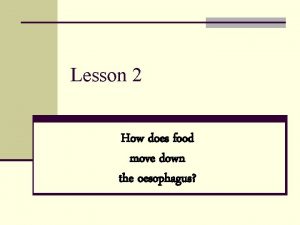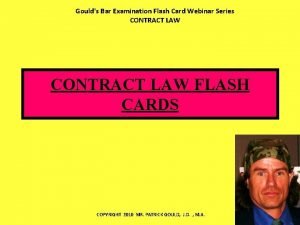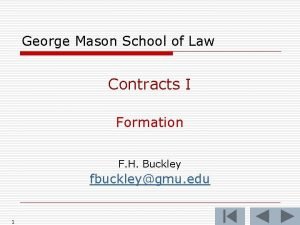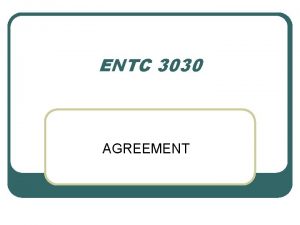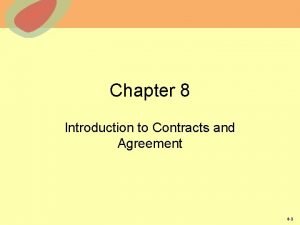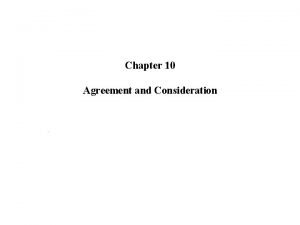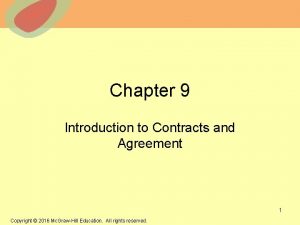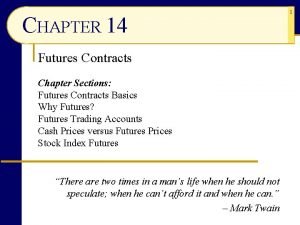Chapter 9 Introduction to Contracts and Agreement 2019

















- Slides: 17

Chapter 9 Introduction to Contracts and Agreement © 2019 Mc. Graw-Hill Education. All rights reserved. Authorized only for instructor use in the classroom. No reproduction or further distribution permitted without the prior written consent of Mc. Graw-Hill Education. 1

Contract • A contract is a set of legally enforceable promises. © 2019 Mc. Graw-Hill Education. 2

Elements Required For Contract Formation • Agreement (Offer and Acceptance). • Consideration (Bargained-For Exchange). • Contractual Capacity (Legal Ability to Enter Into Binding Contract). • Legal Object. © 2019 Mc. Graw-Hill Education. 3

Defenses to Enforcement of Contract • Lack of genuine assent (fraud, duress, undue influence, misrepresentation). • Lack of proper form requirements (statute of frauds writing requirement). © 2019 Mc. Graw-Hill Education. 4

Sources of Contract Law State common law. The Uniform Commercial Code (Article 2). • Governs contracts for the sale of goods. © 2019 Mc. Graw-Hill Education. 5

Classification of Contracts: Express or Implied “Express” Contract: Based on written or spoken words. “Implied” Contract: Based on conduct or actions. • “Quasi-Contract” (“Implied-in-law” contract): Imposed in certain cases to avoid unjust enrichment, even if all elements of contract formation not satisfied. © 2019 Mc. Graw-Hill Education. 6

Classification of Contracts Bilateral • The offeror and offeree both exchange promises. • A promise for a promise. Unilateral • The offeror makes a promise and asks for acceptance by performing an act. • A promise for an act. • Examples are contests and rewards. © 2019 Mc. Graw-Hill Education. 7

Classification of Contracts: Valid, Void, or Voidable • “Valid” Contract: All elements of contract formation satisfied. • “Void” Contract: Illegal purpose/subject matter; unenforceable. • “Voidable” Contract: One or both parties can withdraw from contract. © 2019 Mc. Graw-Hill Education. 8

Classification of Contracts: Executed or Executory • “Executed” Contract: All terms of contract fully performed. • “Executory” Contract: Some duties under contract not performed by one/both parties. © 2019 Mc. Graw-Hill Education. 9

Classification of Contracts: Formal or Informal “Formal” Contract: Must meet special form requirements. • Examples: Contracts under seal, “recognizances, ” letters of credit, and negotiable instruments. “Informal” Contract: No formalities required in making; a “simple” contract. © 2019 Mc. Graw-Hill Education. 10

The Agreement: Offer and Acceptance © 2019 Mc. Graw-Hill Education. 11

Elements of a Valid Offer Manifestation of offeror’s intent to be bound. • Intent determined by objective, “reasonable person” standard. • Preliminary negotiations and advertisements do not constitute offers. Definite and certain terms (including subject matter, price, quantity, quality, and parties). Communication of offer to offeree (or offeree’s agent). © 2019 Mc. Graw-Hill Education. 12

Auctions Auction With Reserve: • Seller merely expresses intent to receive offers. • Auctioneer (as representative of seller) may withdraw item from auction at any time before “hammer falls. ” • Before hammer falls (signaling acceptance of offer), bidder/offeror may revoke bid. Auction Without Reserve: • Seller must accept highest bid. © 2019 Mc. Graw-Hill Education. 13

Termination of Offer • Revocation by Offeror. • Rejection by Offeree. • Death/Incapacity of Offeror. • Destruction/Subsequent Illegality of Subject Matter of Offer. • Lapse of Time/Failure of Condition(s) Specified in Offer. © 2019 Mc. Graw-Hill Education. 14

Acceptance • Represents offeree’s intent to be bound by terms of offer and resulting contract. • Silence generally does not constitute acceptance. • Terms of acceptance must be identical to terms of offer (“Mirror-Image” Rule). • Effective when communicated by offeree to offeror. • If no method of communicating acceptance specified in offer, any reasonable means of acceptance effective (Examples: telephone, mail, fax, e-mail). © 2019 Mc. Graw-Hill Education. 15

The Mirror Image Rule • Under the common law, the offer and the acceptance must be mirror images of each other. They cannot contain additional or different terms. • Article 2 of the UCC modifies this rule in sale of goods contracts. © 2019 Mc. Graw-Hill Education. 16

The Mailbox Rule • Acceptance by mail is effective when placed in mailbox; however, revocation of offer is effective only when received by offeree. © 2019 Mc. Graw-Hill Education. 17
 Affirmative positive
Affirmative positive State government entities certified agreement 2019
State government entities certified agreement 2019 A muscular bag secretes gastric juice and mixes food around
A muscular bag secretes gastric juice and mixes food around Singular subject of walk
Singular subject of walk Forward contract hedging
Forward contract hedging Research and development contracts
Research and development contracts Water contracts (gets smaller) when it freezes
Water contracts (gets smaller) when it freezes Software contracts in professional practices
Software contracts in professional practices Litter picking contracts
Litter picking contracts System operation contracts
System operation contracts International contracts
International contracts Classification of contract
Classification of contract Mailbox rule contracts
Mailbox rule contracts Mailbox rule contracts
Mailbox rule contracts Contract parts
Contract parts Next-generation smart contracts
Next-generation smart contracts Mailbox rule contracts
Mailbox rule contracts Financial contracts
Financial contracts


